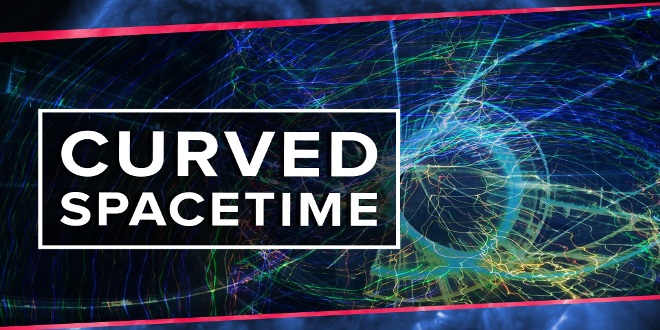Albert Einstein wrote the General Theory of Relativity in 1915. General Relativity generalizes both Newton’s Law of Universal Gravitation and Einstein’s Special Theory of Relativity to model a unified description of gravitational force as a property of spacetime. Specifically, the curvature of spacetime is directly related to the energy and momentum of all matter and radiation present at a given point.
Special Relativity has been oft-verified by experimentation and measurement. General Relativity less so, because some of the predictions made by General Relativity cannot be observed directly. There is strong evidence of the existence of black holes, for example; however, because of the curvature of spacetime inside the event horizon of a black hole prevents light from escaping it, direct observations of black holes cannot be made. That said, there are volumes of indirect observations that indicate black holes exist as predicted by General Relativity.
Another prediction made by General Relativity is the existence of gravitational waves, ripples in the curvature of spacetime that propagate as waves from a source. This prediction was thought to be impossible to detect directly, due to a lack of technological advancement necessary to make a sensor sensitive enough to detect even the strongest gravitational waves. Thought to be undetectable, that is, until the Laser Interferometer Gravitational-Wave Observatory (LIGO) detected them, according to an announcement from the LIGO team on February 11, 2016.
This discovery might be the most important case of technology and observation verifying theory since General Relativity was written 100 years ago.
How They Did It: LIGO
LIGO is a laser interferometer. An interferometer is a tool by which interference in light is measured, hence the name interferometer being a mash-up of interference and -ometer. Interferometers are hardly a new technology—the first one was invented in the late 1800s by Albert Michelson. The use of interferometers in experimentation is hardly new, either, and the Michelson Interferometer was put to use in 1887 as a part of the Michelson-Morley Experiment. That experiment was designed to prove or disprove the existence of an æther thought to permeate the universe and act as a medium for light waves to propagate through, similar to the way sound waves propagate through air.
Laser light is passed through a beam splitter, which as the name suggests splits the beam of laser light into 2 identical beams of laser light. One of the split beams is reflected perpendicularly to the original beam, while the other beam passes straight through the beam splitter. Each beam is reflected back to the beam splitter where the 2 beams of light merge to reform a single beam of light. In doing so, the beams of light interfere with each other. Finally, a photodetector measures the brightness of the resultant beam of laser light. If the distance traveled by the split beams is identical, then the photodetector will measure exactly the original beam of laser light, or nothing at all. LIGO is configured to show nothing if the split beams of light travel identical distances.
LIGO’s configuration is key to detecting gravity waves. A gravity wave would change the distance of the mirrors in the interferometer such that the photodetector would measure some amount of light intensity. The systems for trying to limit the number of false positives include active and passive dampening, the second largest sustained vacuum environment on Earth, highly advanced optics, custom built software, and supercomputers at a handful of institutions.
To say the technology required for this discovery is impressive is an understatement of the highest order.
What Did LIGO See?
According to the February 11, 2016 announcement, LIGO detected gravitational waves from the collision of 2 massive black holes. Estimates from LIGO scientists suggest the black holes were about 29 and 36 times the mass of our sun, respectively. In this collision, approximately three solar masses of mass were converted to gravitational waves in a fraction of a second. The peak power output of this conversion is estimated at roughly 50 times the power output of every currently visible entity in the universe combined.
The final massive burst of energy as the block holes collide is emitted as gravitational waves, per Einstein’s equation of mass energy equivalence: E=mc2. It’s these gravity waves that LIGO detected in September, 2015, ultimately culminating in the announcement in February, 2016.
What In the Name of Spacetime Does It Mean?
First, the detection of gravity waves by LIGO introduces an entirely new field of scientific study, gravitational astronomy. Theory suggests black hole collisions are not a unique phenomenon, and instruments like LIGO, and the upcoming Laser Interferometer Space Antenna (LISA), should be able to detect them. The more these events are detected and combined with other observations, the more scientists will understand about gravity waves and the early universe.
Second, the technologies behind LIGO and LISA have applications outside of the scientific community, and a success by LIGO in detecting gravity waves should make the funding path for more LIGO-esque interferometers and LISA smoother, as well as demonstrate the application of the associated technologies. For example, the dampening technologies used in LIGO could pave the way for 3D printing or manufacturing on extremely small scales.
Third, direct observation of predictions made by General Relativity further solidify the theory as an accurate model of the universe. As theoretical physicists continue to try and reconcile General Relativity with other models, like Quantum Mechanics, knowing predictions from General Relativity are backed up by observation removes some uncertainty from a long list of potential trouble spots when trying to reconcile theories or models not backed up by measurement.
Finally, from the, “OMG Star Trek!” file are the corollaries the detection of gravity waves might have as indirect observations of the graviton.
There are 4 fundamental forces in the universe: electromagnetism (light), the strong nuclear force, the weak nuclear force, and gravity. Three of the four fundamental forces are known to be mediated by particles. Electromagnetism is mediated by the photon; the strong nuclear force is mediated by gluons; the weak nuclear force is mediated by the W and Z bosons. The implication of 3 of the 4 fundamental forces being mediated by a particle is gravity should also by mediated by a particle, the aptly named graviton.
If the graviton does exist, it should be massless, based on the apparent unlimited range of the force of gravity. If the graviton is massless, it is subject to wave-particle duality like the photon. LIGO just detected gravity waves. Undoubtedly, one of the ongoing courses of study with the LIGO data is to determine if there’s evidence of particle-like interactions anywhere surrounding the gravity wave detection event. The discovery of the graviton would move science one step closer to unification of the four forces and should give greater insight into the state of the very early universe.
The success of LIGO, like so many things in STEM, is the result of superhuman effort from an enormous team of scientists, engineers, and support staff. The discovery of gravitational waves is supremely cool to me personally, as I studied physics at university.
The detection of gravity waves is among the biggest scientific discoveries in the last 100 years. I'm excited to see what happen next.
Have a tip, or want to point out something we missed? Leave a Comment or e-mail us at tips@techraptor.net













